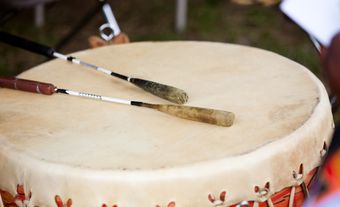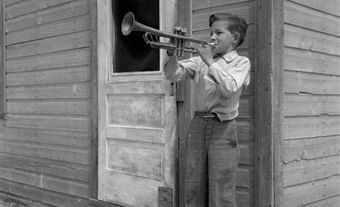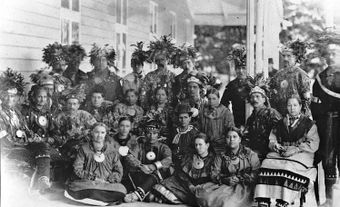“Jesous Ahatonhia” (“Jesus Is Born”), also known as “'Noël Huron,” was the first Canadian Christmas carol. Though widely believed to have been written by the Jesuit missionary Jean de Brébeuf (1593–1649), who taught the song to the Wendat near Georgian Bay circa 1642, it is not known whether the verses of “Jesous Ahatonhia” were written to fit the melody (apparently derived from the 16th-century French song “Une Jeune Pucelle”) with which they have come to be associated.
Unrecorded for 100 years, the carol was collected from the Wendat by Father de Villeneuve, a Jesuit stationed 1747–94 at Lorette, Quebec. The words were translated from the original Wendat into French by Paul Picard, an Indian notary at Quebec City. This version was published in Ernest Myrand’s Noëls anciens de la Nouvelle-France (1907). An English-language version by Jesse Edgar Middleton was adapted for voice and piano by Healey Willan as part of the pageant Brébeuf. It was later expanded for choir around 1954. The version in Songs for Worship (1930) was also Willan's.
A third version, composed by Barrie Cabena, was published in the Hymn Book (1971). There is also an arrangement (1929) by Champagne — “Estenniaton de tsouvé'” — for SATB and piano or orchestra (manuscript) and one by Richard Johnston for TTBB and piano (1953). Champagne also used the Wendat text of the carol in his Altitude (1959).
Notable recordings include the Toronto Consort's version using the original Wendat text (1984) and Métis singer Tom Jackson's. Choral versions include interpretations by the Mennonite Children's Choir, the Armdale Chorus, the Toronto Children's Chorus and the Boys' Choir of Toronto. Eric Robertson’s Prelude on the Huron Carol has been recorded by Liona Boyd. The 1977 Canadian postage stamp Christmas series illustrated the theme of the carol.

 Share on Facebook
Share on Facebook Share on X
Share on X Share by Email
Share by Email Share on Google Classroom
Share on Google Classroom



